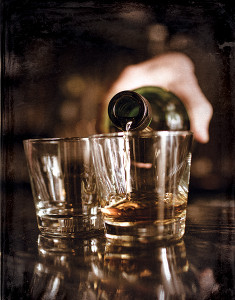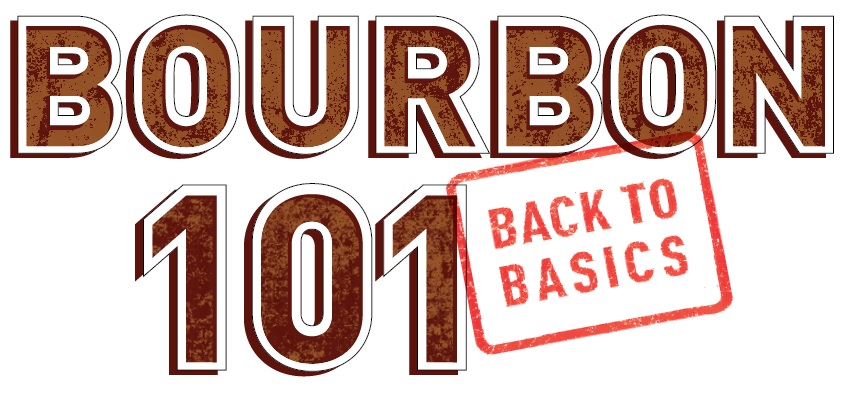
By Jeff Cioletti
When people talk about the worldwide whiskey renaissance, the first word that comes to most minds is bourbon. Sure, other styles are on fire at the moment—Irish, American rye, even Canadian—but the one that’s got most of the globe talking is America’s native spirit.
A couple of decades ago, producers could barely give the stuff away—it was “grandpa’s drink” after all—but today bars in the most far-flung corners of the world (even Scotland!) have multiple shelves dedicated to the U.S.-made, corn-based whiskey.
Where Is It Produced?
Federal law dictates that only bourbon whiskey produced in the U.S. can be called “bourbon.” And the U.S. has numerous trade agreements with other countries to enforce that restriction as well. It is most closely linked to Kentucky, where it originated, where about 95% of it is made and where the style’s most iconic brands hang their hats (and they’re the only ones that can claim the prestigious label, “Kentucky Straight Bourbon”).
Did You Know?
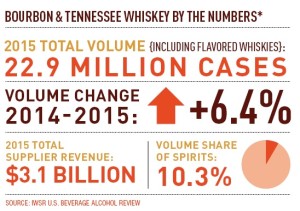 Because bourbon is so closely associated with Kentucky, many had assumed it took its name from the Bluegrass State’s Bourbon County. However, that notion has been challenged and largely debunked. Many historians assert that it’s more likely bourbon took its name from Bourbon Street in New Orleans. True, most of the distillers were in Kentucky, but in the 19th century, a large number of the spirit’s drinkers were in the Big Easy (sent there via the Mississippi River). Eventually people started referring to the whiskey as “that stuff they drink on Bourbon Street,” or so the story goes.
Because bourbon is so closely associated with Kentucky, many had assumed it took its name from the Bluegrass State’s Bourbon County. However, that notion has been challenged and largely debunked. Many historians assert that it’s more likely bourbon took its name from Bourbon Street in New Orleans. True, most of the distillers were in Kentucky, but in the 19th century, a large number of the spirit’s drinkers were in the Big Easy (sent there via the Mississippi River). Eventually people started referring to the whiskey as “that stuff they drink on Bourbon Street,” or so the story goes.
What’s It Made From?
The first rule (and there are several) is that bourbon’s mash bill must be at least 51 percent corn (though many go considerably higher). The remainder tends to be wheat, rye, barley or any combination of those.
How Is It Made?
Decisions to be made at the distilling stage include the ratio of corn/grains; types of yeast; and distillation strength and barrel strength.
- The grains are milled into flour and cooked with water.
- After the mash is cooled to a temperature hospitable to yeast, it’s time to ferment, usually for around three days. It produces a beer-like beverage often referred to as “distiller’s beer.”
- That liquid is then distilled to no more than 160 proof and must then go into the barrel at no more than 125 proof (it’s diluted with water to bring the proof down).
- In order for it to be called “straight bourbon” it must be aged for two years. Top brands age for at least four years. If the maturation period is under
four years, the label must have an age statement. If there’s no age statement, it’s safe to assume it’s spent at least four years in the barrel.
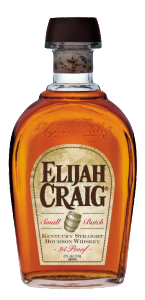 FEATURED BRAND: Elijah Craig
FEATURED BRAND: Elijah Craig
Elijah Craig embraces not only bourbon’s historic origin, but also its current-day quality and range of expressions. The brand is named for the Rev. Elijah Craig, aka the “Father of Bourbon,” the man who first stored his whiskey in barrels that had been charred in a fire. Production of Elijah Craig Bourbon remains unapologetically hands-on.
Small Is Beautiful
The brand’s most important expression, Elijah Craig Small Batch, was first introduced in 1986, before the term “small batch” was ever popularized. Among its signature qualities:
- Made from 8- to 12-year-old bourbon, Small Batch delivers perfectly balanced taste; smooth yet full-flavored, thanks to extra aging
- Each batch is bottled exclusively from a dumping of 200 barrels or less
- New premium packaging brings enhanced shelf presence
Critical Acclaim
Elijah Craig Small Batch was awarded a double gold medal at the San Francisco World Spirits Competition. It has twice been awarded “Best of the Best” from Whisky Magazine. And in 2014, the Small Batch won a Gold Medal at the WSWA Spirits Tasting Competition.
Featured Elijah Craig Cocktail: The Gold Rush
- 2 oz Elijah Craig Small Batch
- 3/4 oz Domaine de Canton
- 1/2 oz Fresh lemon juice
Combine all ingredients in a mixing glass, add ice and shake until well chilled. Strain into a cocktail glass and garnish with a Luxardo cherry.
Now About Those Barrels…
It can be argued that bourbon was the first purposefully wood-aged whiskey style. The barrel rules and regimens continue to play a huge role in the finished product:
- The barrels must be made from new American oak
- The inside is charred
- The may not be used again for bourbon – one and done
But lucky for Kentucky, the wood needn’t be retired. Bourbon rules may dictate single use for the barrels, but most other whisk(e)y styles have no such requirement. Ex-bourbon barrels have held everything from Scotch to Japanese whisky (ex-Sherry casks are quite popular as well), for varying periods of time, depending on the particular flavor profile the distiller wishes to achieve. The used
bourbon casks are more in demand than they’ve ever been, especially as barrel-aged craft beers have become all the rage.
Water, Water…
The distinctiveness of Kentucky Bourbon owes a great deal to the limestone-rich water in the state, known for its alkalinity (high pH, the opposite of low-pH acidity) and its minerality.
Common Uses
- Higher-end bourbons are meant to be savored, often with a drop or two of water to open up the flavor, or over one large cube of ice.
- Ditto for barrel-proof bourbons (anywhere from 110 to upwards of 140 proof).
- While higher-end bourbons would make amazing cocktails, keep in mind that means letting the other ingredients dilute and overshadow something people pay premium for.
Old Fashioned:
- The Old-Fashioned actually fits the original definition of “cocktail” published in 1806: spirit, bitters, water and sugar. Typically served over ice.
- Bourbon, rye or other available whiskies were likely the main ingredient in the originals; brandy was also commonly used.
- There are many variations; common components beyond the core four ingredients are a slice of orange peel (with just enough fruit to juice the rim) and a cocktail cherry.
Manhattan:
- It shares a lot in common with the Old Fashioned, except for the addition of vermouth.
- Ice is plays a less prominent role in the final pour; usually it’s shaken with the bourbon, bitters and vermouth, but the liquid often is strained out, sans cubes.
Mint Julep:
- A staple of the weeks surrounding the Kentucky Derby, the Mint Julep is made with muddled mint, simple syrup, bourbon and crushed ice, garnished with a sprig of fresh mint (pretty much like a snow cone for adults).
- Its proper vessel: a shiny metallic cup (most are stainless steel or silver plated; fancier ones are pewter and even sterling silver).
Selling Point
Although it did not become official until 1964, bourbon is the only distinctly American spirit. And it has never been better and more varied in options as it is today. For whiskey novices, bourbon is a good choice because its taste profile is sweeter than malt whiskies. Connoisseurs will relish the various single-barrel, highproof and limited-edition bottlings. And as America’s spirit, it makes a great gift, at diverse price points.
FEATURED BRAND: Jim Beam Black
Raising the bar with extra age. With bourbon sales on fire, product line extensions
have proliferated. Among the most notable: Jim Beam Black, which just took home top honors—the“Bourbon Trophy”—at the International Wine & Spirits
Competition (IWSC). This 86 proof Jim Beam Black ages years longer in white oak barrels than original Jim Beam. It appeals to whiskey drinkers who are looking
to “trade up” and spend a little more on their bourbon. This expression demonstrates the impact of extra aging: a more advanced, complex bourbon experience—fullbodied, with smooth caramel and warm oak notes.
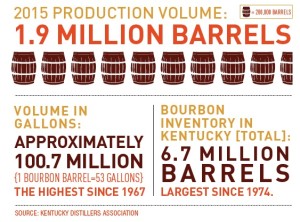 Bourbon Fun Facts
Bourbon Fun Facts
- Kentucky produces 95% of the world’s bourbon supply, but by definition it can be produced in any state.
- Though all bourbon must be aged, there is no minimum aging requirement; products labeled straight bourbon whiskey must be aged at least two years.
- Before Prohibition there were over 2,000 distilleries in Kentucky, now there are fewer than 30.
- The first bottled bourbon was sold in 1870; prior to that, the whiskey was shipped in barrels directly to taverns.
What’s It Taste Like?
- Corn, gives it a sweeter profile than malt whiskey
- Caramel and vanilla, are the more pronounced notes, thanks to the barrel
- There also can be spicy hints, as well as a bit of nuttiness.
- The non-corn grains play a significant role in the overall profile
- High-rye bourbons bring a lot of the grain’s spicy character
- Wheated bourbons tend to be softer and a touch sweeter
Types of Bourbon
- Straight Bourbon: Bourbon that must be aged for at least two years.
- Kentucky Straight Bourbon: Must be made in Kentucky.
- Small Batch: Bourbon from a small number of barrels – the definition of “small” varies from distillery to distillery and there’s no set standard.
- Single Barrel: Everything in that bottle came from a lone barrel.
- Barrel Proof: Bourbon bottled at the strength from which it emerged from the barrel without the addition of water to bring down the ABV.
FEATURED BRAND: Old Hickory Great American Whiskey
Bottled History
Deeply rooted in America’s bourbon tradition, Old Hickory Great American Whiskey delivers character reminiscent of Andrew Jackson, acclaimed U.S. President, General and Statesmen. “Old Hickory,” as Jackson was known, was a connoisseur of fine whiskey, and enjoyed his own blend from a distillery on the grounds of his Tennessee plantation home.
Hallmarks of Old Hickory
- Each expression of Old Hickory is made from 100% brand-owned stocks.
- All the corn is sourced from farms within a 250-mile radius of the distillery.
- Water used to distill Old Hickory is drawn from glacial aquifers dating back 1.2 million years which formed the Ohio River basin as it looks today.
Old Hickory White Label
- Proof: 86 proof, the traditional “perfect proof” preferred historically by American distillers
- Character: Rich and near mahogany in color; intense spice and oak aromas; bold, masculine style, with notes of cedar and gingerbread
- Finish: Long, with hints of pie crust and sweet tobacco
- Usage: modern whiskey cocktails and bourbon connoisseur
Old Hickory Black Label
- Proof: 80 proof (combination of bourbon and whiskey)
- Character: Amber in color; attractive aromas of cherry custard, pistachio gelato and almond nougat; silky texture; medium-to-full bodied taste
- Finish: lingering flavors of white toffee, dried cherry and honey custard
- Usage: traditional mixing or sipping straight
Share this link or download and read via PDF.

